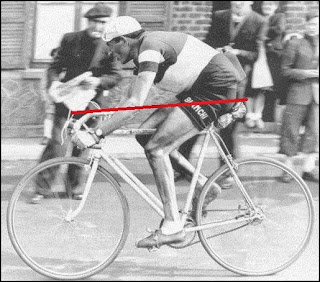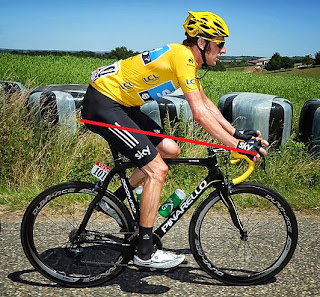Let me tell you about a guy I occasionally ride with. He used to ride a pretty "traditional" styled road bike that he'd owned since the 1980s. Level top tube. Quill-type stem. Bars maybe an inch or two lower than the saddle. He was a pretty enthusiastic rider, but no racer. When I'd see him, he usually wore a mountain bike style of helmet (you know the ones, with the attached visor on the front). Why not, he figured, since he also liked riding his mountain bike, and why should he get different helmets for different bikes? I agreed. But he couldn't understand why his other riding friends -- "serious roadies" all of them -- sniggered about the visored helmet.
Not too long ago, this riding acquaintance got a new bike with modern "compact" frame geometry and lots of the latest innovations. Out for a ride on the new bike, this person suddenly understood the sniggers about his helmet. The visor kept blocking his view of the road ahead unless he totally craned his neck. Why? The relationship between the bars and the saddle on the new bike put him in a much lower position than the old bike. Off came the visor.
Road bike designs have changed a lot in the last couple decades. Racing bike positioning has gotten much more aggressive, and other road bikes have followed that trend. I'm not going to even attempt to say whether the more aggressive position is good or bad for racing, but when that becomes the model for other road bikes, most of which are
not raced, it seems that the world is a little topsy turvy.
Take a look at some racing bikes and racers from the past:
![]() |
| Fausto Coppi, circa 1950 |
![]() |
| Eddy Merckx, early 70s |
![]() |
| Laurent Fignon, 1980s. |
![]() |
| Fignon, again. |
![]() |
| Bernard Hinault, in an old Gitane ad - probably early 80s. |
![]() |
| Bernard Hinault and Greg LeMond in 1986. |
![]() |
This is the track bike Eddy Merckx used to break the hour
record in 1972. The perspective angle of the photo might be
throwing it off a little, but that bar/seat relationship is probably
closer than a lot of road bikes today. |
Next take a look at some bikes and riders of today:
![]() |
Bradley Wiggins's 2012 TdF bike. Note how low the stem
puts the bars, but then Wiggins has the bars angled upwards
just a bit. It must work for him. |
![]() |
Wiggins in the 2012 TdF. Notice that with his hands on the tops
of the brake hoods, he's not sitting much higher than riders of
the past when they were down in the drops. |
![]() |
| One of Alberto Contador's TdF bikes. |
![]() |
Contador, racing in Spain, I believe. Note again, the
"on the hoods" position. |
I found an interesting article on Dave Moulton's Blog:
Frame Design Then and Now. (Dave built the bike I recently added to my collection, seen
here). Dave Moulton is about as knowledgable as anyone can be about racing bike design, and in his article he describes how frame design has changed in the last few decades. He confirms that racers of the past rode in a more upright position compared to now, with their bars higher in relation to their saddles. As Dave explains, that change is at least partly due to changing bottom bracket height.
The way he describes it, racing bikes once had much lower bottom brackets than today. His own racing bike from the 1950s had a BB height of 23.5 cm. A similar bike today would have a BB height of 27 cm. (a difference of about 1 1/2 inches). Raising the BB leads to a higher saddle, as the saddle will be raised for proper leg extension. However, the handlebars and stem do not necessarily get raised by the same amount. When the BB is lower, the seat ends up being lower in relation to the bars. On smaller frames, particularly, there is a limit as to how low one can practically get the bars, as the wheel size and fork length are "fixed" measurements regardless of frame size. Interesting to note, at the end of that article, Dave concludes that the racing position one
used to see in decades past is probably a good position for recreational riders today.
Another thing that has changed in bike design is the move to "compact" geometry, which is an unfortunate carryover from mountain bikes, which in turn took their clues from BMX bikes. Road bike frames in the past had a level top-tube, and good quality bikes were offered in many frame sizes -- usually in 2-cm. increments (some builders offered 1-cm. increments!). With compact geometry, the top-tube slopes downward from the head-tube to the seat-tube, making for a much lower stand-over height. In addition, the compact frames are often sold in "t-shirt" sizing -- S, M, L, and maybe XL. Whatever "fine-tuning" someone needs to make the bike fit is accommodated with seriously long seat posts and different length stems. The manufacturers claim that the benefit is lower weight (That's negligible. The seat-tube and seat-stays are shorter, therefore they must be lighter -- then again, there's a much longer seat post in place which offsets some of the weight savings). But in reality, there is virtually
no benefit for the rider. The real benefit is very much that the manufacturers save a lot by making and stocking fewer frame sizes. There's probably a good bit of savings on the cost of tooling molds for carbon fiber frames, too. Fewer sizes means fewer molds.
How does compact geometry lead to lower bars? In fact, it doesn't
need to, since in actuality, eliminating the somewhat arbitrary need to have a level top-tube means that head-tubes can be longer, and bars could in fact be
higher -- and there are
some bikes that are designed in that way. But on bikes that follow the racing trends, what happens is that frames are made long in reach from the seat-tube to the head-tube (I'd say "top-tube length," but that isn't really accurate on a compact frame -- it's more of a "virtual" measurement on a more-or-less imaginary horizontal line), but very short in the vertical measurements, including the seat-tube as well as the head-tube. Combine that with the high bottom bracket described earlier, and the saddle gets shot high up in the air, while the stem and bars remain low by comparison.
Here's yet another thing that leads to lower bars: threadless stems and carbon fork steerers. Threadless stems don't offer as much vertical adjustability as the traditional quill-type stems, because their height adjustability is somewhat limited by the length of the steerer. If a steerer is made of steel, it can be left very long without really losing much in strength -- but it isn't recommended to have carbon steerers extend too far above the head-tube or the top of the headset (how far is "too far" I really just don't know -- but suffice it to say, it's less than with steel).
So racing bikes with compact geometry, high bottom brackets, and carbon steerers, all combine to make a much greater difference between the heights of the saddle and the bars. What we see from this is that it puts the rider into a lower, flatter-back position, especially when down in the drops or "in the hooks." One other result is that it seems to me that riders (including racers) spend a lot more time in that "on the hoods" riding position. I think this effect especially can be seen with non-racers who are riding bikes that are overly influenced by the modern racing bike DNA -- for anyone who isn't as fit or flexible as a professional cyclist, getting down into the drops or the hooks of the bars means straining a lot more in the neck and shoulders, so they ride much more on the hoods. Further evidence of this trend is that all the integrated brake/shift systems seem to work best from that position, and some are even a little difficult to shift from the drops.
Wrapping it up, it seems to me that the "racing" position of the past is more than aggressive enough for any physically fit, non-racing, "sporting" rider of today -- I mean, it didn't slow down Fignon or Hinault any. I would perhaps go a little farther than Dave Moulton's assessment, and say that a "recreational" rider might even want their bars a little higher still (although we could be defining "recreational" differently) -- maybe within an inch of the top of the saddle. One of my
favorite bikes has bars than are barely an inch lower than my saddle, and I feel like I can ride that bike all day. On it, I frequently switch hand positions from the tops to the drops to the hooks, and feel comfortable in all of them.









